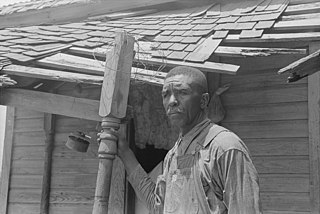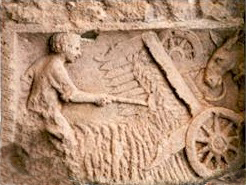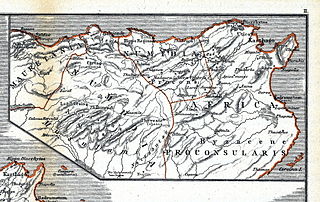Related Research Articles

Enclosure or inclosure is a term, used in English landownership, that refers to the appropriation of "waste" or "common land", enclosing it, and by doing so depriving commoners of their traditional rights of access and usage. Agreements to enclose land could be either through a formal or informal process. The process could normally be accomplished in three ways. First there was the creation of "closes", taken out of larger common fields by their owners. Secondly, there was enclosure by proprietors, owners who acted together, usually small farmers or squires, leading to the enclosure of whole parishes. Finally there were enclosures by acts of Parliament.

A tenant farmer is a person who resides on land owned by a landlord. Tenant farming is an agricultural production system in which landowners contribute their land and often a measure of operating capital and management, while tenant farmers contribute their labor along with at times varying amounts of capital and management. Depending on the contract, tenants can make payments to the owner either of a fixed portion of the product, in cash or in a combination. The rights the tenant has over the land, the form, and measures of payment vary across systems. In some systems, the tenant could be evicted at whim ; in others, the landowner and tenant sign a contract for a fixed number of years. In most developed countries today, at least some restrictions are placed on the rights of landlords to evict tenants under normal circumstances.

Sharecropping is a legal arrangement in which a landowner allows a tenant (sharecropper) to use the land in return for a share of the crops produced on that land. Sharecropping is not to be conflated with tenant farming, providing the tenant a higher economic and social status.

A lease is a contractual arrangement calling for the user to pay the owner for the use of an asset. Property, buildings and vehicles are common assets that are leased. Industrial or business equipment are also leased. In essence, a lease agreement is a contract between two parties: the lessor and the lessee. The lessor is the legal owner of the asset, while the lessee obtains the right to use the asset in return for regular rental payments. The lessee also agrees to abide by various conditions regarding their use of the property or equipment. For example, a person leasing a car may agree to the condition that the car will only be used for personal use.
A leasehold estate is an ownership of a temporary right to hold land or property in which a lessee or a tenant has rights of real property by some form of title from a lessor or landlord. Although a tenant does hold rights to real property, a leasehold estate is typically considered personal property.

Roman agriculture describes the farming practices of ancient Rome, during a period of over 1000 years. From humble beginnings, the Roman Republic and the Roman Empire expanded to rule much of Europe, northern Africa, and the Middle East and thus comprised many agricultural environments of which the Mediterranean climate of dry, hot summers and cool, rainy winter was the most common. Within the Mediterranean area, a triad of crops were most important: grains, olives, and grapes.

Run rig, or runrig, also known as rig-a-rendal, was a system of land tenure practised in Scotland, particularly in the Highlands and Islands. It was used on open fields for arable farming.

Agriculture in the Empire of Japan was an important component of the pre-war Japanese economy. Although Japan had only 16% of its land area under cultivation before the Pacific War, over 45% of households made a living from farming. Japanese cultivated land was mostly dedicated to rice, which accounted for 15% of world rice production in 1937.
Thangata is a word deriving from the Chewa language of Malawi which has changed its meaning several times, although all meanings relate to agriculture. Its original, pre-colonial usage related to reciprocal help given in neighbours' fields or freely-given agricultural labour as thanks for a benefit. In colonial times, between 1891 and 1962, it generally meant agricultural labour given in lieu of a cash rent, and generally without any payment, by a tenant on an estate owned by a European. Thangata was often exploited, and tenants could be forced to work on the owners' crops for four to six months annually when they could have cultivated their own crops. From the 1920s, the name thangata was extended to situations where tenants were given seeds to grow set quotas of designated crops instead of providing cash or labour. Both forms of thangata were abolished in 1962, but both before and after independence and up to the present, the term has been used for short-term rural casual work, often on tobacco estates, which is considered by workers to be exploitative.

The metayage system is the cultivation of land for a proprietor by one who receives a proportion of the produce, as a kind of sharecropping. Another class of land tenancy in France is named fermage, whereby the rent is paid annually in banknotes. A farm operating under métayage was known as a métairie, the origin of some place names in areas where the system was used, such as Metairie, Louisiana.
In the late Roman Empire and the Early Middle Ages a colonus was a tenant farmer. Known collectively as the colonate, these farmers operated as sharecroppers, paying landowners with a portion of their crops in exchange for use of their farmlands.

Thignica was a town in the Roman province of Africa Proconsularis. It served as a Latin Catholic titular see.
The Natives on Private Estates Ordinance, 1928 was a colonial ordinance passed by the Legislative Council of the Nyasaland Protectorate. The body was composed mainly of senior colonial officials, with a minority of nominated members, to represent European residents. The ordinance regulated the conditions under which land could be farmed by African tenants on estates owned by European settlers within that protectorate. The legislation corrected some of the worst abuses of the system of thangata under which tenants were required to work for the estate owner in lieu of paying rent.
The British Central Africa Company Ltd was one of the four largest European-owned companies that operated in colonial Nyasaland, now Malawi. The company was incorporated in 1902 to acquire the business interests that Eugene Sharrer, an early settler and entrepreneur, had developed in the British Central Africa Protectorate. Sharrer became the majority shareholder of the company on its foundation. The company initially had trading and transport interests, but these were sold by the 1930s. For most of the colonial period, its extensive estates produced cotton, tobacco or tea but the British Central Africa Company Ltd developed the reputation of being a harsh and exploitative landlord whose relations with its tenants were poor. In 1962, shortly before independence, the company sold most of its undeveloped land to the Nyasaland government, but it retained some plantations and two tea factories. It changed its name to The Central Africa Company Ltd and was acquired by the Lonrho group, both in 1964.
Villamagna in Proconsulari was a town in the Roman province of Africa Proconsulare. It is identified with the modern village of Henchir Mettich, located around 50 km from Carthage in Tunisia.

Henchir Mettich is a town of the Bagradas Valley region in Tunisia, c.50 km west of the ancient city of Carthage. The area around Henchir Mettich is currently a semi-arid district of mostly barren hills, some of which are currently cultivated with olive trees.

Henchir-El-Hatba is a village and an archaeological site in Tunisia. It was a Roman Catholic diocese.

Henchir-Aïn-Dourat, also known as Ad-Duwayrat or Henchir Durat, is a former Roman–Berber civitas and archaeological site in Tunisia. It is located at 36.767496n, 9.524142e, in the hills just north of Toukabeur and 15.3 km (9.5 mi) from Majāz al Bāb. It was an ancient Catholic diocese.
Henchir-Ed-Douamès is an archaeological site and locality in Tunisia, located 120 km southwest of Tunis, in the Governorate of Béja, near Dougga. It is identified with the ancient city of Uchi Maius.

Numidia was a Roman province on the North African coast, comprising roughly the territory of northeastern Algeria.
References
- ↑ Scheding, Paul (2019). Urbaner Ballungsraum im römischen Nordafrika. Zum Einfluss von mikroregionalen Wirtschafts- und Sozialstrukturen auf den Städtebau in der Africa Proconsularis [Urban agglomeration in Roman North Africa. On the influence of micro-regional economic and social structures on urban development in Africa Proconsularis]. Wiesbaden: Reichert, ISBN 978-3-95490-313-9, p. 40.
- ↑ Tenney Frank, A Commentary on the Inscription from Henchir Mettich in Africa The American Journal of Philology Vol. 47, No. 2 (1926), pp. 153-170.
- ↑ Flach, Dieter. "" Inschriftenuntersuchungen zum römischen Kolonat in Nordafrika "". Chiron . 8: 441–492, see particularly 443.
- ↑ Scholl, Reinhold; Schubert, Charlotte (2004). "Lex Hadriana de agris rudibus und lex Manciana". Archiv für Papyrusforschung 50, pp. 79-84, here p. 79.
- 1 2 Kehoe, D, 1988, Econonmics of Agriculture on Roman Imperial Estates in North Africa, Göttingen: Vandenhoeck & Ruprecht